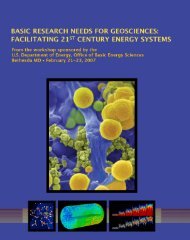Measurement Science Roadmap for Net-Zero Energy Buildings
Measurement Science Roadmap for Net-Zero Energy Buildings
Measurement Science Roadmap for Net-Zero Energy Buildings
- No tags were found...
Create successful ePaper yourself
Turn your PDF publications into a flip-book with our unique Google optimized e-Paper software.
integrated power generation systems will include high-density energy storage <strong>for</strong>grid regulation.Mid to long Term: There will be continued development of smart controllers <strong>for</strong>integrated power generation systems.Integration of SystemsNear Term: A single interconnection standard will be needed to incentivizedevelopment and reduce regulatory barriers to self-generation. Uni<strong>for</strong>m utilitycontrol standards that facilitate installation and communication of networkeddevices. Standard interfaces will enable the integration of “plug and play” PVsystems. Predictive cost benefit models will assess the per<strong>for</strong>mance of PV systems<strong>for</strong> individual customers.Mid to long Term: Generating technologies will be more responsive, particularlywaste heat utilization and CHP; generation will be tightly managed and will bedispatch-able.C. Broad ChallengesThe broad challenges related to onsite energy production are both technical andnon-technical. They involve barriers unique to the integration of generationsystems with buildings, the need <strong>for</strong> energy storage, incentivizing investment <strong>for</strong>high risk, high cost renewable energy systems, and overcoming current buildingindustry philosophies and structure.Technical ChallengesRenewable energy systems face a number of challenges <strong>for</strong> use in buildings. Someof the most critical include reliability of renewable energy systems over time, andpredicting the actual per<strong>for</strong>mance of these systems versus expectations basedupon limited rating data⎯a practice that often leads to over-prediction ofinstalled per<strong>for</strong>mance. Solar photovoltaic (PV) systems are impeded by the highinvestment required, which means long and unattractive payback periods <strong>for</strong>many building operators and owners. Onthe technology side, maintenance andreliability of concentrating solarcollectors remains a challenge. Standardtechniques to integrate PV onresidential, commercial, and skyscrapersare also lacking. Communicationbarriers also exist between sensors,smart grid systems, and renewableenergy systems. Related to this is theneed <strong>for</strong> accurate predictive softwareand per<strong>for</strong>mance metrics <strong>for</strong> integratedpower generation systems.NIST’s outdoor residential photovoltaic testfacility is used to collect per<strong>for</strong>mance data<strong>for</strong> model improvement and validation.(Photo: NIST)Urban power challenges include naturalhazard control (e.g., maintaining system reliability and energy production underconditions such as hurricanes, fire, snow, hail, thunderstorms) is a challenge that8 <strong>Measurement</strong> <strong>Science</strong> <strong>for</strong> <strong>Net</strong>-<strong>Zero</strong> <strong>Energy</strong> <strong>Buildings</strong>
















